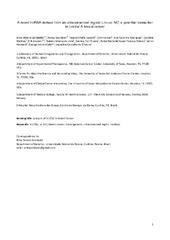| dc.contributor.author | Zambalde, Erika Pereira | |
| dc.contributor.author | Bayraktar, Recep | |
| dc.contributor.author | Jucoski, Tayana Schultz | |
| dc.contributor.author | Ivan, Cristina | |
| dc.contributor.author | Rodrigues, Ana Carolina de Mello Alves | |
| dc.contributor.author | Mathias, Carolina | |
| dc.contributor.author | Knutsen, Erik | |
| dc.contributor.author | Silveira de Lima, Rubens | |
| dc.contributor.author | Gradia, Daniela Fiori | |
| dc.contributor.author | Fonseca, Enilze Maria de Souza | |
| dc.contributor.author | Hannash, Samir | |
| dc.contributor.author | Calin, George A. | |
| dc.contributor.author | Oliveira, Jaqueline Carvalhode | |
| dc.date.accessioned | 2022-03-17T14:03:30Z | |
| dc.date.available | 2022-03-17T14:03:30Z | |
| dc.date.issued | 2021-08-13 | |
| dc.description.abstract | The human genome contains 481 ultraconserved regions (UCRs), which are genomic stretches of over 200 base pairs conserved among human, rat, and mouse. The majority of these regions are transcriptionally active (T-UCRs), and several have been found to be differentially expressed in tumours. Some T-UCRs have been functionally characterized, but of those few have been associated to breast cancer (BC). Using TCGA data, we found 302 T-UCRs related to clinical features in BC: 43% were associated with molecular subtypes, 36% with oestrogen-receptor positivity, 17% with HER2 expression, 12% with stage, and 10% with overall survival. The expression levels of 12 T-UCRs were further analysed in a cohort of 82 Brazilian BC patients using RT-qPCR. We found that uc.147 is high expressed in luminal A and B patients. For luminal A, a subtype usually associated with better prognosis, high uc.147 expression was associated with a poor prognosis and suggested as an independent prognostic factor. The lncRNA from uc.147 (lnc-uc.147) is located in the nucleus. Northern blotting results show that uc.147 is a 2,8 kb monoexonic trancript, and its sequence was confirmed by RACE. The silencing of uc.147 increases apoptosis, arrests cell cycle, and reduces cell viability and colony formation in BC cell lines. Additionally, we identifed 19 proteins that interact with lnc-uc.147 through mass spectrometry and demonstrated a high correlation of lnc-uc.147 with the neighbour gene expression and miR-18 and miR-190b. This is the first study to analyse the expression of all T-UCRs in BC and to functionally assess the lnc-uc.147. | en_US |
| dc.description | This is an Accepted Manuscript of an article published by Taylor & Francis in RNA Biology on 13. august 2021, available (including supplementary) material online: https://doi.org/10.1080/15476286.2021.1952757. | en_US |
| dc.identifier.citation | Zambalde, Bayraktar R, Jucoski, Ivan C, Rodrigues ACdMA, Mathias, Knutsen E, Silveira de Lima, Gradia, Fonseca, Hannash, Calin GA, Oliveira. A novel lncRNA derived from an ultraconserved region: lnc- uc.147, a potential biomarker in luminal A breast cancer. RNA Biology. 2021;18(1):416-429 | en_US |
| dc.identifier.cristinID | FRIDAID 1975386 | |
| dc.identifier.doi | 10.1080/15476286.2021.1952757 | |
| dc.identifier.issn | 1547-6286 | |
| dc.identifier.issn | 1555-8584 | |
| dc.identifier.uri | https://hdl.handle.net/10037/24443 | |
| dc.language.iso | eng | en_US |
| dc.publisher | Taylor & Francis | en_US |
| dc.relation.journal | RNA Biology | |
| dc.rights.accessRights | openAccess | en_US |
| dc.rights.holder | Copyright 2021 The Author(s) | en_US |
| dc.title | A novel lncRNA derived from an ultraconserved region: lnc- uc.147, a potential biomarker in luminal A breast cancer | en_US |
| dc.type.version | acceptedVersion | en_US |
| dc.type | Journal article | en_US |
| dc.type | Tidsskriftartikkel | en_US |
| dc.type | Peer reviewed | en_US |


 English
English norsk
norsk